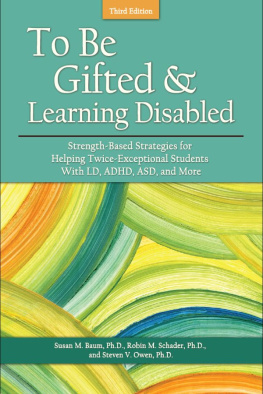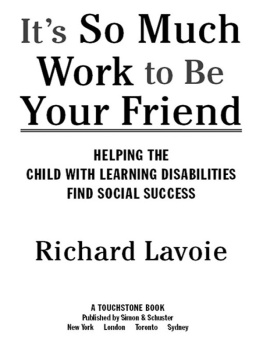NO EASY ANSWERS
A Bantam Book
PRINTING HISTORY
Winthrop edition published June 1979
Bantam mass market edition published January 1981
Bantam trade paperback edition/March 1995
All rights reserved.
Copyright 1979, 1980, 1995 by Sally L. Smith.
No part of this book may be reproduced or transmitted in any form or by any means, electronic or mechanical, including photocopying, recording, or by any information storage and retrieval system, without permission in writing from the publisher.
For information address: Bantam Books.
Library of Congress Cataloging-in-Publication Data
Smith, Sally Liberman.
No easy answers : the learning disabled child at home and at school / Sally L. Smith. Rev. ed., Bantam trade pbk. ed.
p. cm.
eISBN: 978-0-307-80980-3
1. Learning disabled childrenEducation. 2. Home and school.
I. Title.
LC4704.S625 199594-36478
Bantam Books are published by Bantam Books, a division of Bantam Doubleday Dell Publishing Group, Inc. Its trademark, consisting of the words Bantam Books and the portrayal of a rooster, is Registered in U.S. Patent and Trademark Office and in other countries. Marca Registrada. Bantam Books, 1540 Broadway, New York, New York 10036.
v3.1
CONTENTS
PREFACE
The first edition of No Easy Answers: The Learning Disabled Child at Home and at School was published by Bantam in 1981. More than a decade later Bantam is bringing out a new edition to help parents and teachers unlock the mysteries of learning disabilities. I wrote the book because I wished I had owned such a book in the 1960s when my son with severe learning disabilities (whats now called ADHD) was growing up. The insights of a desperate mother, dealing with the vital needs of a child crying out for assistance, were the passionate beginnings of my knowledge about learning disabilities. I read everything that was written on the subject, and in 1967 I had the audacity (and perhaps navet) to design and direct a school for my son, and others like him, when there was no such thing available.
No Easy Answers: The Learning Disabled Child at Home and at School is based on my own experience. As mother, teacher, school administrator, and university professor, I have lived with the problems of the learning disabled every day since the early 1960s. The thousands of children with severe learning disabilities who attended The Lab School and an extraordinarily gifted faculty have been my teachers since 1967.
I was the Founder/Director of The Lab School, which was situated from 1967 to 1982 at the Kingsbury Center in Washington, DC. Twenty-eight years later I am still actively managing the school. In 1982, we became an independent body, The Lab School of Washington, with the same program, the same students and parents, and the same faculty. Independence allowed the school to expand from 80 students to 250 students spanning kindergarten through twelfth grade with an after-school arts and sports program. A diagnostic clinic with testing and tutoring services for the community and a training course for tutors began in 1983.
In 1984, The Night School for seventy-five to ninety adults with learning disabilities was added. A Wednesday-night lecture-discussion series began in 1985 to offer parents and those who aid them in the Washington metropolitan community a forum to explore feelings and problems related to raising a child or adolescent with learning disabilities. Large departments of occupational therapy, speech and language therapy, and psychotherapy grew to serve the wider Washington community as well as the school.
In 1985, to offer encouragement and motivation to our students and parents, The Lab School began giving Outstanding Learning Disabled Achiever Awards to celebrities with learning disabilities who had distinguished themselves in a particular field. A career- and college-counseling center specifically tailored for the learning disabled opened its doors in 1987. In 1993, the International Materials and Services Center was inaugurated in order to share Lab School materials, techniques, and methods with others in our country and abroad.
In 1975, I began teaching at The American University. In 1976, I became full-time faculty and associate professor in charge of the graduate program in special education: learning disabilities, and in 1982, I became professor. Now, in 1995, I am still teaching and in charge of the department of special education in The School of Education. I have been forced to learn everything I can so that the graduate students will have access to the latest research and practices in the field, and children with learning disabilities will be better served.
This new edition of No Easy Answers contains all the original information with updates where necessary. I have added more material on the related disorders of Attention Deficit Disorder (ADD) and Attention-Deficit/Hyperactivity Disorder (ADHD), on the gifted child with learning disabilities, the nursery-school youngster who is at risk for learning disabilities, more on behavior management, a final chapter on Educating the Learning Disabled for the Future, and a whole new Appendix of current resources.
Sally L. Smith
January 1995
PREFACE TO THE FIRST EDITION
As we enter the 1980s we are able to control many aspects of our lives by push buttons, levers, switches, computers, test tubes, and nuclear energy, but we still have to deal with many of the human issues over which we have little control. We each wrestle with feelings, relationships, and values daily, and the way in which we deal with them determines the quality of the life we lead. There are rarely easy answers, simple solutions, perfect ways to handle human problems. This is especially true with the learning problems of children. Not machines but the brains and hearts of human beings are needed to help children overcome these problems. Compassion is not enough, although it is always welcome. Knowledge in depth of the child, his particular learning problems, and the tasks we are asking him to do are needed in order to help a learning disabled child to function effectively in school and in society.
This book is an introduction to the world of the learning disabled child. It is about the intelligent youngster who has trouble learning, not about the retarded or the emotionally disturbed child. It is about the child whose nervous system is delayed in maturing. He looks typical for his age, but he does not learn as other children his age do because he has a hidden handicap. In some ways, this child is similar to a much younger child, although in other ways he functions at his own age level or above. His wide scattering of abilities and disabilities makes him into a very uneven, inconsistent, unpredictable child who puzzles the adults around him.









